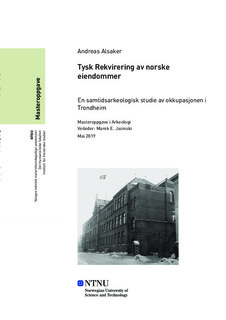Tysk Rekvirering av norske eiendommer - En samtidsarkeologisk studie av okkupasjonen i Trondheim
Master thesis
Permanent lenke
http://hdl.handle.net/11250/2625232Utgivelsesdato
2019Metadata
Vis full innførselSamlinger
Sammendrag
After the German occupation of Norway on April the 9th 1940 Hitlers growing fear of an Allied invasion of Norway and the German military’s needs for the country, lead to many German soldiers and other staff being stationed in Norway, both to protect it against the predicted allied invasion and to supervise the expansion of the Norwegian infrastructure. The need to house the large number of German soldiers and personnel would partly be solved with the construction of camps, but the requisition of Norwegian property and housing that started with the invasion would continue to be an alternative solution throughout the war. The occupation radically changed the daily life of the Norwegians, and the rationing and nightly blackouts are aspects of the war. these are often brought up in books and among those who experienced the occupation. Compared to these aspects the need for Norwegians to share their homes, schools and properties with the occupying Germans, are rarely a subject that is touched upon in greater depth. While the material culture of rationing and blackout are still widely known today in the form of ersatz goods and blackout blinds, the remnants of the appropriation of properties in Trondheim is today widely unknown. This Master’s thesis is a contribution to the interdisciplinary research project Painful Heritage and focuses on the identification and evaluation of properties in the city of Trondheim that were appropriated by the German military and other German organizations staying in Trondheim during the war. The thesis analyses the possible advantages the Germans thought to gain by the expropriation of the properties, and the material remnants of the requisitions that can be found at the properties today. The identification of properties has been done by the study of the existing archives of the communal office that existed during the war, whose job it was to ensure the payment of rent from the Germans to the Norwegian property owners. Based on this source 14 properties in central Trondheim have been identified and have been evaluated in this thesis. These are: Hotel Phønix, Stiftsgården, Misjonshotellet, Trondhjem borgerlige realskole, Frimurerlogen, A.F. Wigen, Folkets Hus, Hotell Britannia, Trondheim turnforening, Synagogen i Trondheim and Befalsforening. 3 properties outside Midtbyen have also been included because of their importance: Studentersamfundet i Trondheim, Munkholmen and Kristiansten festning. A visual landscape analysis of the properties combined with an analysis of the property’s characteristics show that the Germans choice of properties were done with practical concerns in mind, however the choice of buildings that would serve as headquarters for the German organizations seems also to have been done to gain large imposing buildings in the center of Trondheim that could serve as tools in the German propaganda. The possibilities of using requisition as a tool of persecution and punishment against groups in society that either were unwanted by or were in opposition to the German occupiers can be seen in the case of Synagogen, Frimurerlogen and Studentersamfundet. The evaluation of the material remnants of the occupation found at the properties, have shown that the memory of the German requisition is still alive among the users of properties today. These memories are connected to material remains that are perceived as traces of the German occupation. This shows material remains potential value as tool for increasing the awareness of the presence of the German occupation in Norway, particularly their presence outside of the German camps and fortresses that they themselves built in Norway. An aspect of the war that is growing more obscure today as the last witnesses to the war disappears.
